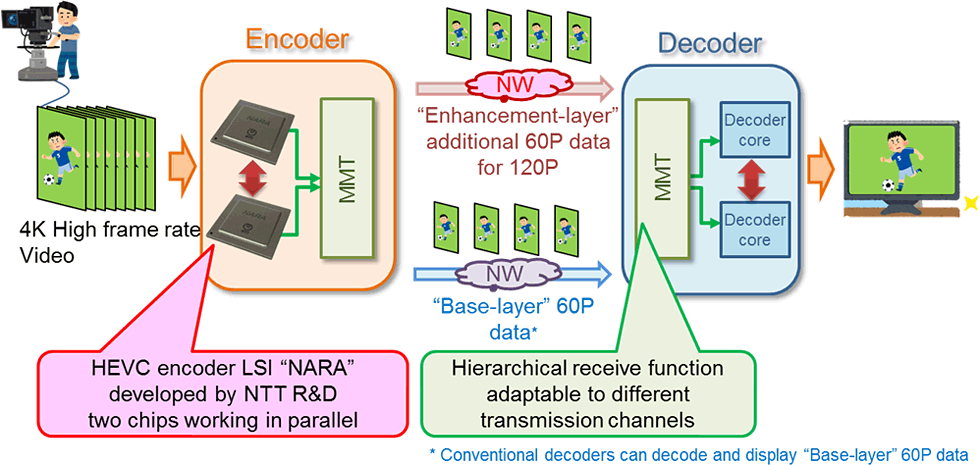Nippon Telegraph and Telephone (NTT) Corporation (Head office, Chiyoda–ku, Tokyo, Japan; Hiroo Unoura, President and CEO) has developed a real–time 4K(*1) high frame rate HEVC(*2) codec which enables live transmission of high frame rate (HFR) video.
HFR enhances video smoothness and sharpness by doubling the frame rate(*3) of the standard video frame rate (SFR), from 50/60p to 100/120p. HFR video is especially effective for fast–moving video content such as sports.
By developing this codec, NTT will contribute to enhancing the quality of broadcasts and public viewing of sporting events. Also, NTT will develop opportunities to use HFR transmission in VR and surveillance applications.

Figure 1
Effectiveness of HFR (left: HFR video, right: SFR video)
1. Development Background
Recently, Ultra HD (UHD) services have launched by many satellite operators and OTT platforms in the world. In March 2015, NTT announced a real–time 4K/60p HEVC video encoder LSI (NARA) and have contributed to the rapid acceptance of UHD service.
Since live sports programs are the main drivers of UHD service, HFR video technologies, which are especially beneficial for sports content, have attracted strong interest from UHD service providers.
NTT’s real–time 4K HFR HEVC codec allows UHD service operators to conduct live broadcasts of HFR sports content.
2. Technical Overview
Both the 4K HFR HEVC encoder appliance and the 4K HFR HEVC decoder appliance, key components of the real–time 4K HFR HEVC codec, are compact 1U size.
The 4K HFR HEVC encoder appliance provides backward compatibility by supporting temporal–scalable encoding(*4), meaning the output stream can be decoded by conventional SFR decoder to yield 4K SFR video.
Moreover, our codec supports the MPEG Media Transport (MMT) protocol(*5) which enables hierarchical transmission. Two independent transmission routes can be used to transfer the base–layer data, which is used for decoding of 4K SFR video, and the enhancement–layer data, which is used together with base–layer data for decoding 4K HFR video.

Figure 2
3. Technical Points
i) Multi chip encoding
By using two “NARA” chips in parallel, the encoder achieves the high speed processing demanded by HFR encoding, while maintaining visual quality by mutual data transfers between the chips.
ii) Hierachical transmission by MMT protocol
MMT protocol enables the base–layer data and enhancement–layer data to be transmitted over different IP streams. Using two different transmission routes creates timing offset in the arrival of the data streams. MMT can reconfigure the order of data by using timestamps based on UTC (coordinated universal time).

Figure 3
4. Future Plans
NTT is planning to proceed with trial experiments of 4K HFR services including video contribution and distribution services for broadcasters and public viewing service. NTT will contribute to the creation of various high–definition and immersive video services by providing this technology.
This real–time 4K high frame rate HEVC codec will be showcased at NAB 2018, the world’s largest exhibition for the media and entertainment industry, in Las Vegas, United States of America, from April 9 to 12.
Glossary
*1. 4K Video – 4K video is the video format that has about 4,000 horizontal lines and about 2,000 vertical lines. There are some variations. TV industry uses 3840 × 2160 (UHD–4K) resolution, while cinema industry uses 4096 × 2160 (DCI–4K) as the standard format.
*2. HEVC (High Efficiency Video Coding) – The latest video compression standard developed through the joint collaboration of international standardization bodies, ITU–T and ISO/IEC.
*3. Frame rate – The number of frames per second. 60p indicates that the video comprises 60 frames per second in progressive scanning.
*4. Temporal Scalable Coding – An output stream of temporal scalable coding contains one or more subset streams. Different frame rate video can be decoded from one video stream by the combined use of subset streams in decoding.
*5. MMT Protocol – MMT (MPEG Media Transport) is the digital container standard developed by MPEG, a working group of international standardization organization ISO/IEC. MMT is designed to distribute media by various transmission routes such as broadcasting network and IP network.

